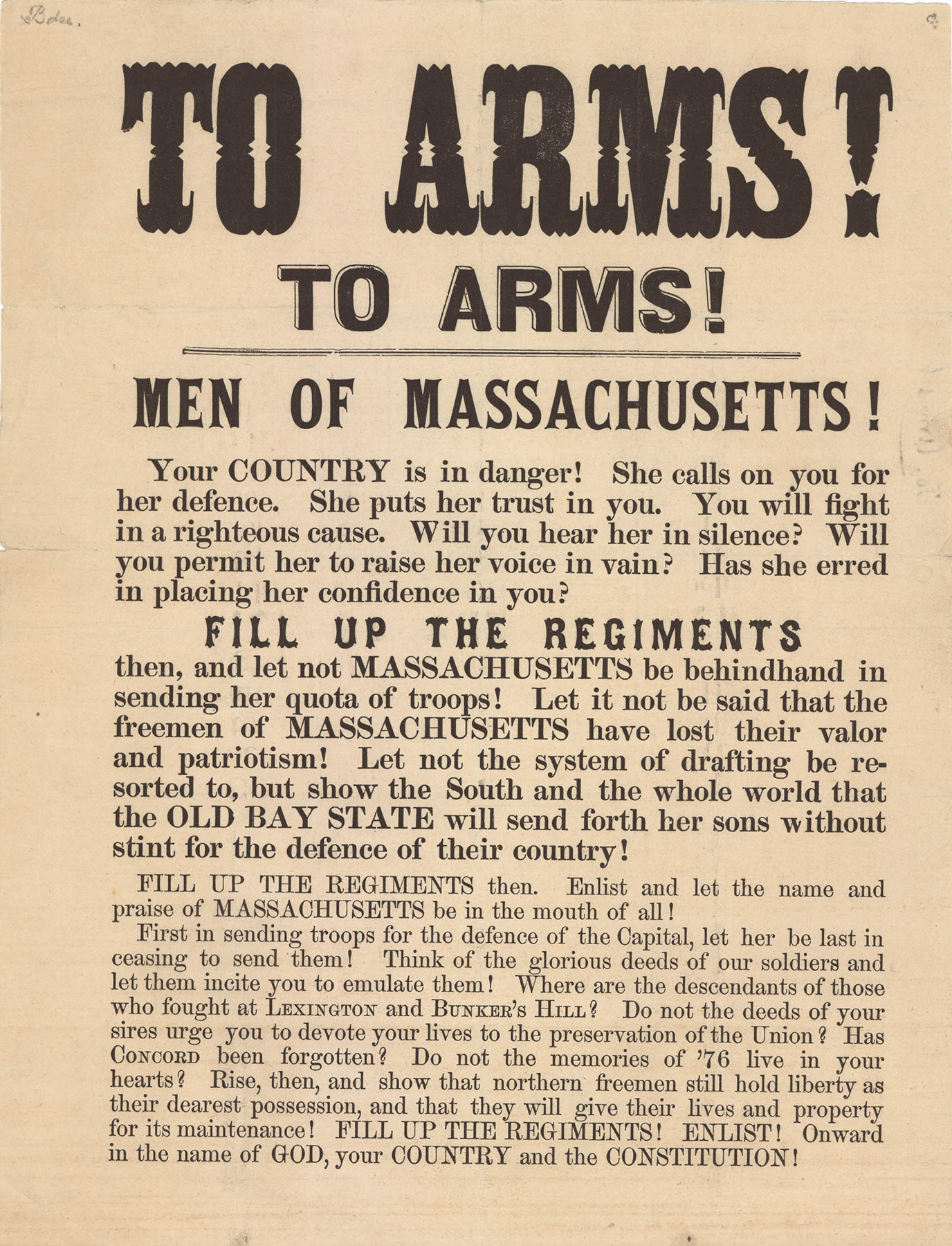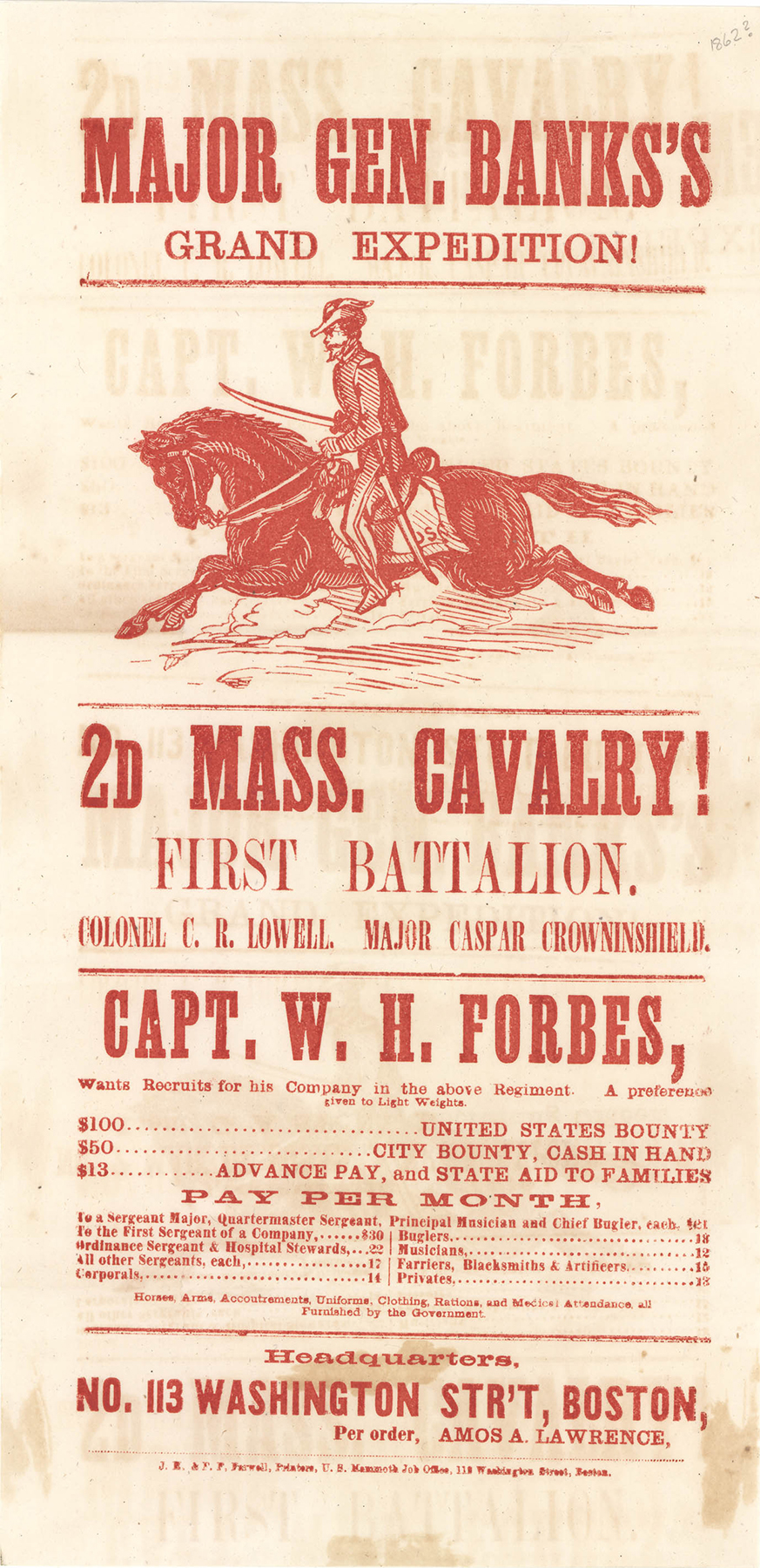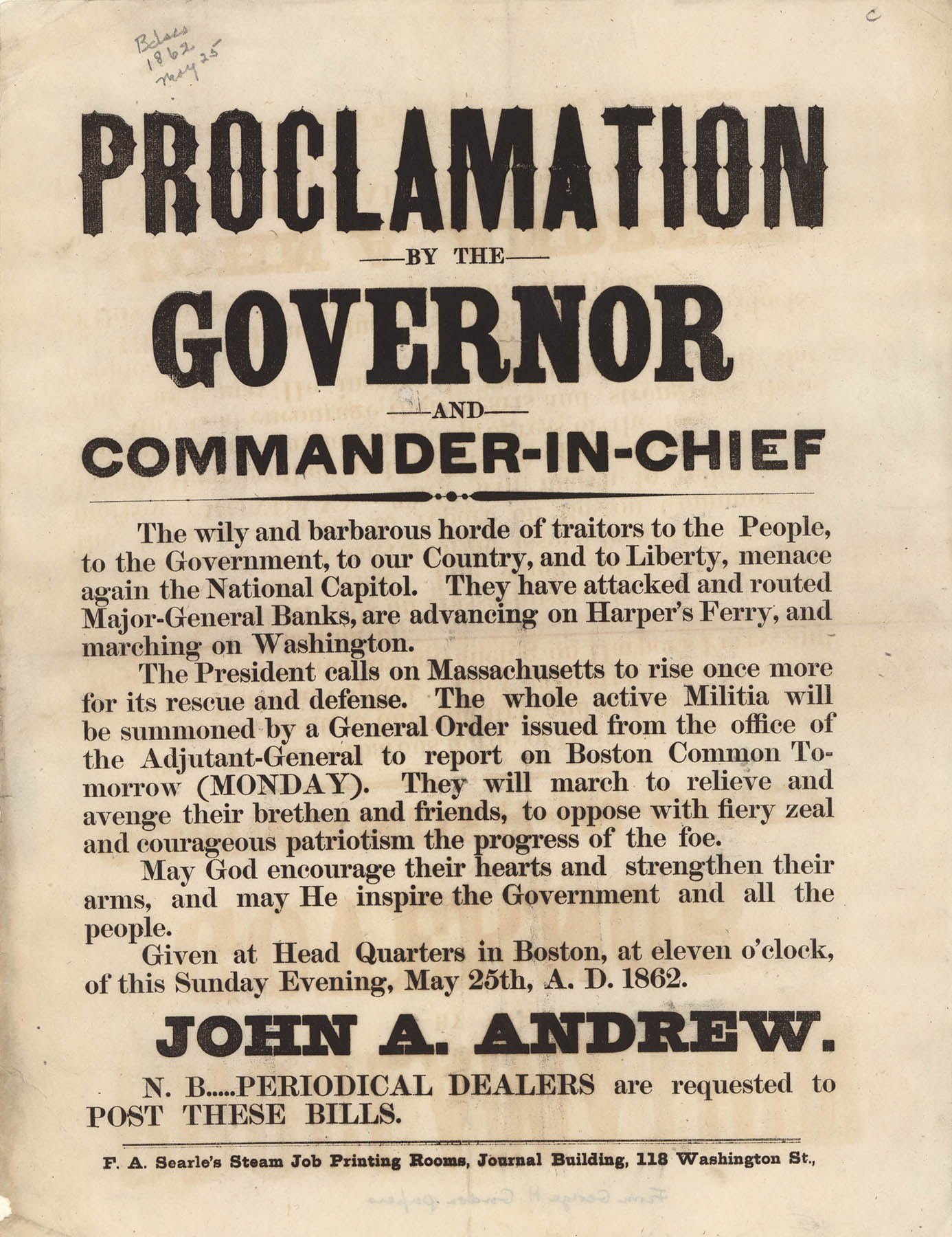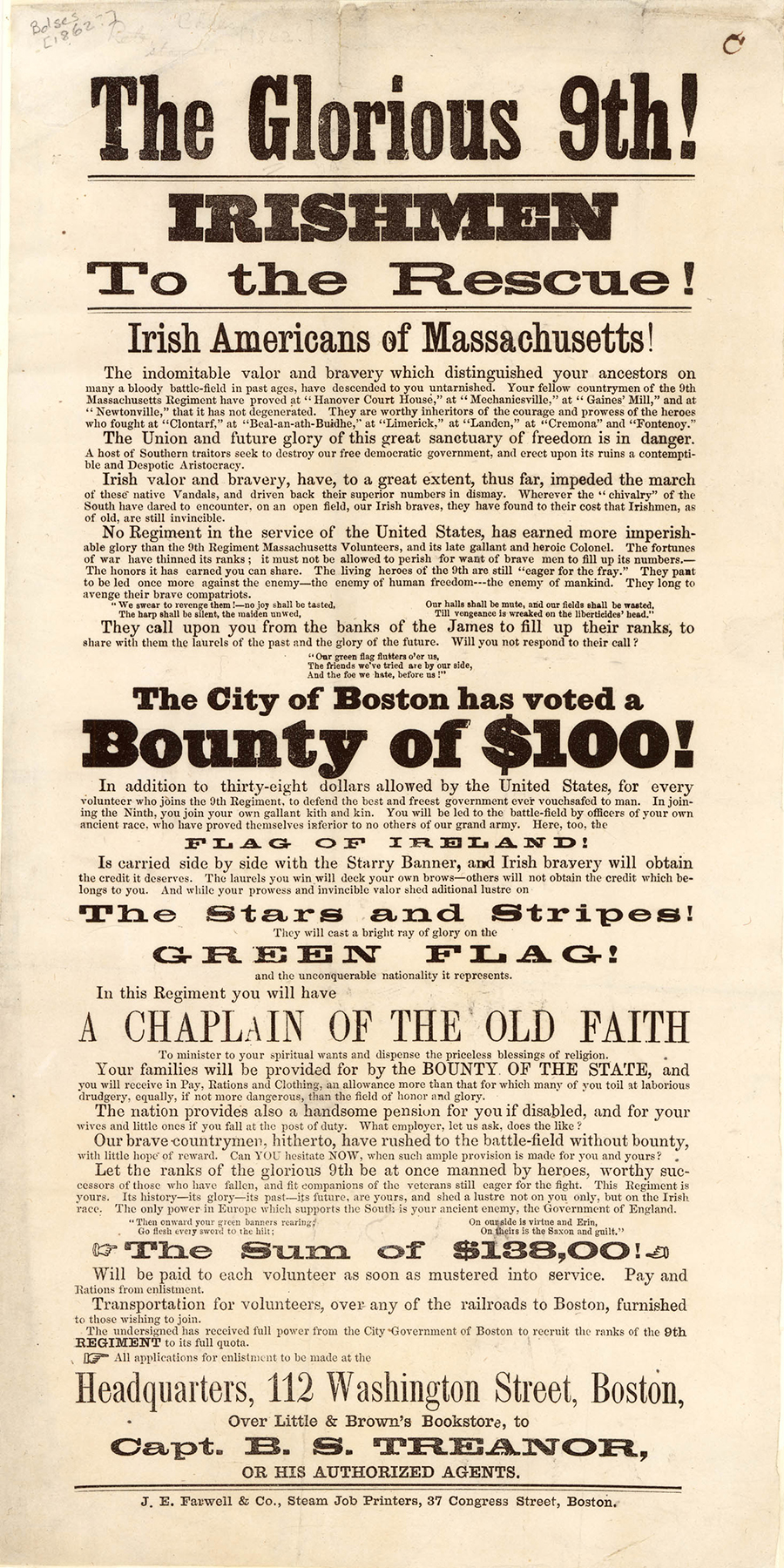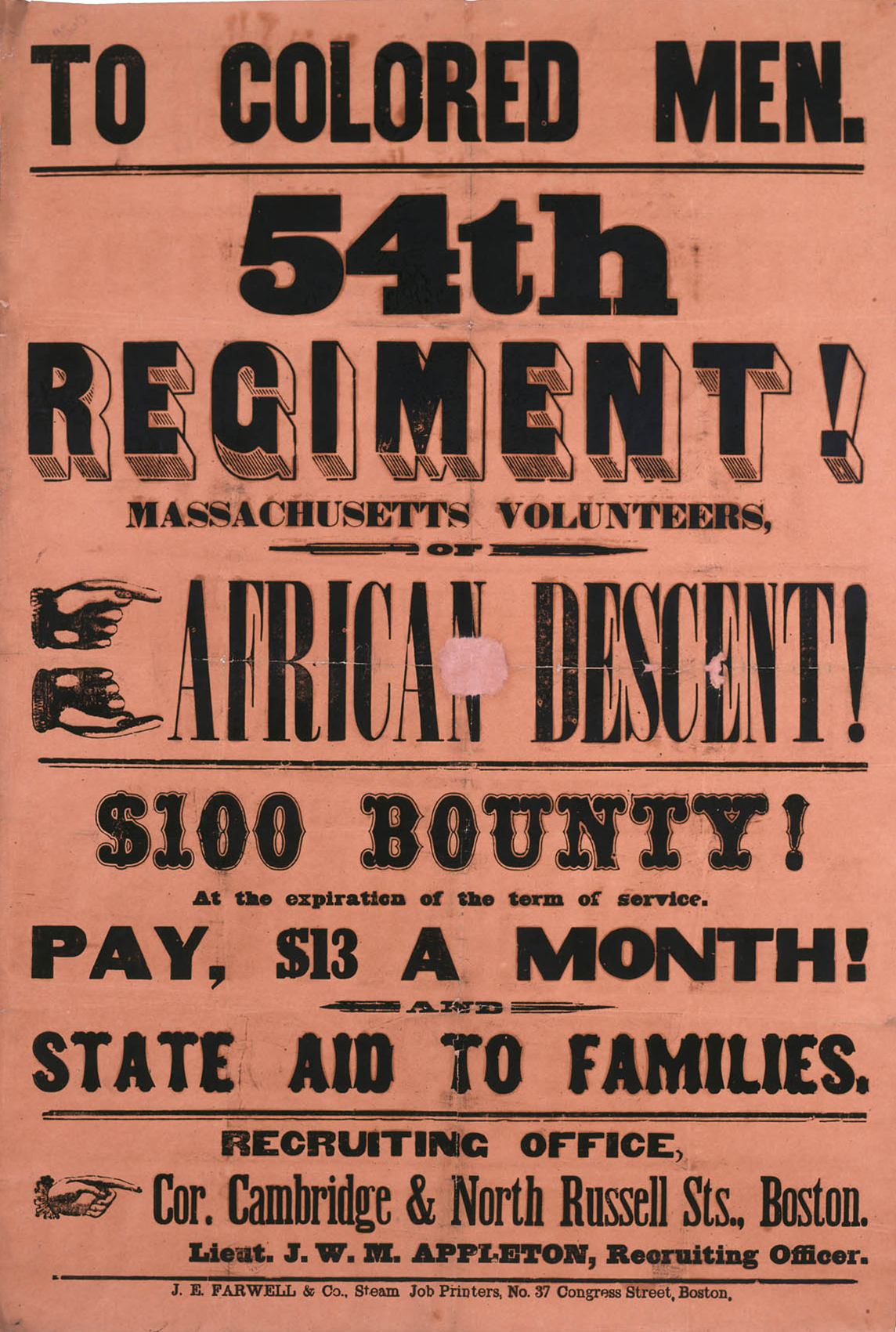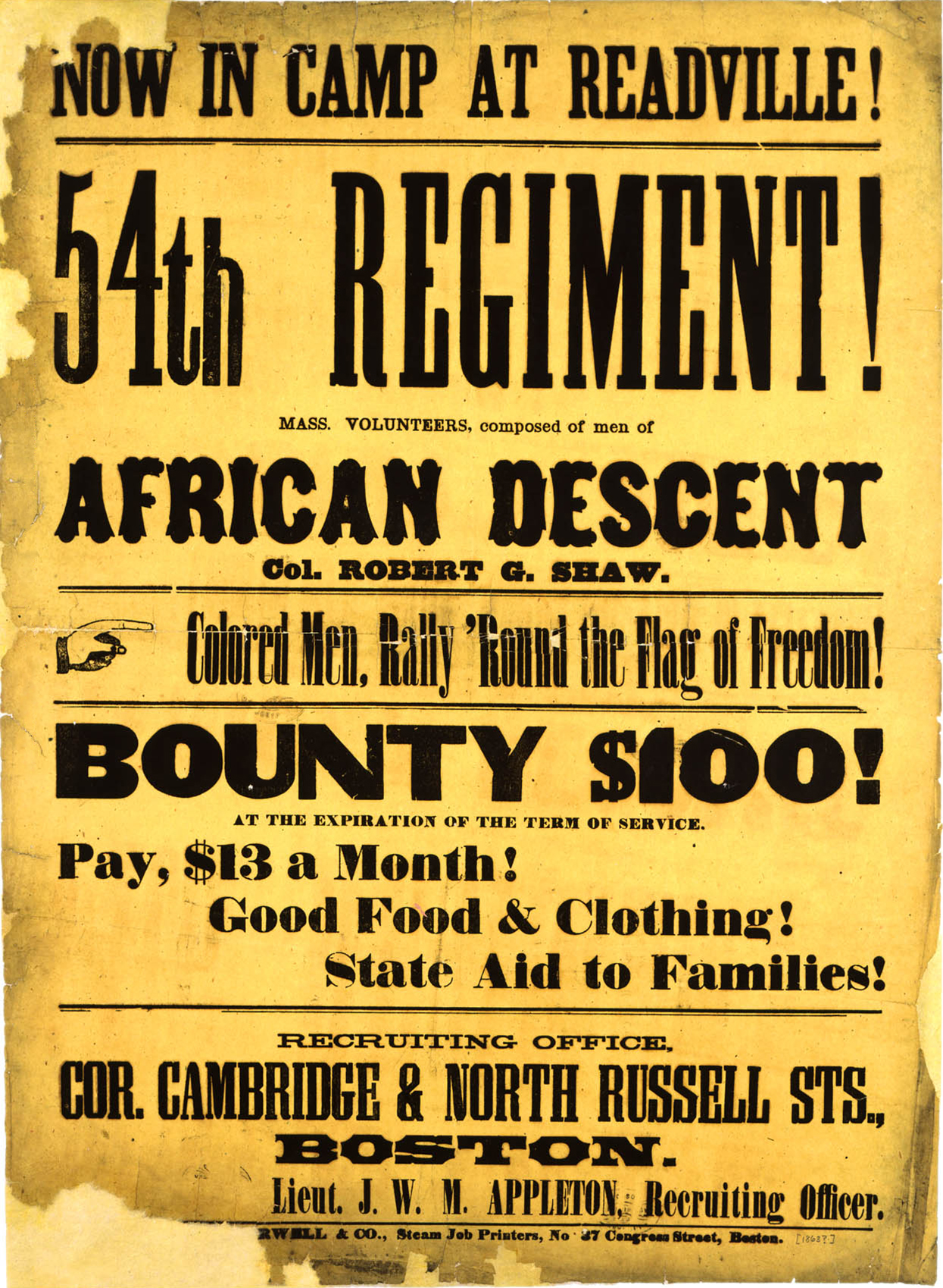Civil War Recruitment Posters
Inquiry Question: What tactics did the authors of the Massachusetts recruitment posters use to persuade their audiences?
Background Reading for Students
After the start of the Civil War in April 1861, men in the North joined the military in large numbers because of patriotism, they believed in the cause they were fighting for. They also believed that it would be a short fight. After a year of war, many realized it would not be over quickly. The military stopped getting people signing up and after many people died, the Union Army really needed men to fight. So in 1862 the government tried to recruit men to the military through recruitment posters. The posters listed how much money men could get for signing up, what the government would do for their families if they were killed in battle, and tried to appeal to people's senses of duty, community, and patriotism. Each poster targeted specific groups of people, sometimes Irish, other times Bostonians, and also tried to enlist African Americans to segregated units. The 54th Massachusetts Regiment was the first all Black unit in the north. Before the 54th, the Union Army had already begun enlisting Black men to serve in regiments in South Carolina, Louisiana, and Kansas. Participation in the Union Army was not easy for African American men. They faced violence, discrimination, bad working conditions, low pay, broken promises, and most significantly, the possibility of being captured by the Confederacy and enslaved.
“To arms! To arms!” 1862
Published in the early years of the Civil War, this broadside[a sheet of paper printed with information that is meant to be shared publicly] recruits[the act of trying to get people to sign up to serve in the armed forces (all of the posters in this set are recruiting for the Union Army)] white men to enlist[to sign up to serve in the army] with Massachusetts regiments. Between 1861-1862, Massachusetts suffered a high number of casualties[a person killed or hurt in a war], and so the Union worked to recruit[the act of trying to get people to sign up to serve in the armed forces (all of the posters in this set are recruiting for the Union Army)] many more soldiers.
Citation: To arms! To arms! : Men of Massachusetts! Your country is in danger! Broadside by Charles P. Bowditch [Boston: 1862] Massachusetts Historical Society, https://www.masshist.org/database/2170.
Your COUNTRY is in danger! She calls on you to fight for her defense. She puts her trust in you. You will fight in a righteous cause
2nd Mass. Cavalry, 1862
This broadside[a sheet of paper printed with information that is meant to be shared publicly] is recruiting[the act of trying to get people to sign up to serve in the armed forces (all of the posters in this set are recruiting for the Union Army)] to fill several positions in the 1st battalion of the 2nd Massachusetts Cavalry–a regiment that rode on horseback.
Civil War regiments were formed based on friendships and group connections. Young men marched off to war with siblings, friends, school and work mates, and, when a regiment had high casualties[a person killed or hurt in a war] in a battle, this led to enormous grief for the soldiers’ shared networks of friends and families.
This was the case for the 2nd Massachusetts Infantry[unit of soldiers fighting on foot] Regiment on 9 August 1862 at Cedar Mountain, in Culpeper County, Virginia. During a long battle, 173 men (out of a regiment of less than 500) died. Of its 22 officers, 16 were killed, wounded, or taken prisoner by the Confederates.
Citation: Major Gen. Banks's Grand Expedition!: 2d Mass. Cavalry! Broadside [Boston : J. E. Farwell, 1862] Massachusetts Historical Society, https://www.masshist.org/database/2171.
Pay per month…Horses, Arms, Accoutrements, Uniforms, Clothing, Rations, and Medical Attendance all Furnished by the Government
Gov. Andrew’s Proclamation, 25 May 1862
John Albion Andrew served as governor of Massachusetts from January 1861 through January 1866. During the Civil War, state governors were responsible for providing troops from their state for service in the Union Army. Early in 1861, Gov. Andrew began raising money and gathering troops to make sure Massachusetts was prepared to help the government. In this broadside[a sheet of paper printed with information that is meant to be shared publicly], he warns that, after defeating the MA 2nd cavalry, the Confederates are closing in on Washington, D.C., and calls up the militia to replace fallen soldiers and strengthen the Union Army.
Andrew remained a strong supporter of Abraham Lincoln and his policies throughout the Civil War.
Citation: Proclamation by the Governor and Commander-in-Chief, Broadside, Boston: F. A. Searle’s Steam Job Printing Rooms, 1862, Massachusetts Historical Society, https://www.masshist.org/database/2196.
The wily and barbarous horde of traitors to the People, to the Government, to our Country, and to Liberty, menace again the National Capitol…[Massachusetts] will march to relieve and avenge their brethren and friends, to oppose with fiery zeal and courageous patriotism the progress of the foe.
“The Glorious 9th! Irishmen to the Rescue!” 1862
In 1861, Governor Andrew supported Irish immigrants in the formation of the 9th Massachusetts Volunteer Infantry[unit of soldiers fighting on foot] Regiment, a regiment for Irish Americans.
After comparing the bravery of Irish soldiers from past wars and battles in Ireland to the bravery of Irish Americans in the Civil War, this broadside[a sheet of paper printed with information that is meant to be shared publicly] notes that the number of soldiers in the 9th have gotten low and attempts to recruit[the act of trying to get people to sign up to serve in the armed forces (all of the posters in this set are recruiting for the Union Army)] additional volunteers. Recruitment[the act of trying to get people to sign up to serve in the armed forces (all of the posters in this set are recruiting for the Union Army)] for the 9th continued throughout the Civil War.
Citation: The Glorious 9th! Irishmen to the Rescue! Irish Americans of Massachusetts! Broadside, Boston: J.E. Farwell & Co., [1862?] Massachusetts Historical Society, https://www.masshist.org/database/2213.
Let the ranks of the glorious 9th be at once manned by heroes, worthy successors of those who have fallen, and fit companions of the veterans still eager for the fight. This Regiment is yours. Its history - its glory - its past - its future, are yours, and shed a lustre not on you only, but on the Irish race.
“To Colored Men. 54th Regiment!” 1863
In early 1863, following President Lincoln's Emancipation Proclamation, and in need of additional soldiers, Governor Andrew began to recruit[the act of trying to get people to sign up to serve in the armed forces (all of the posters in this set are recruiting for the Union Army)] Black soldiers. The 54th Massachusetts Infantry[unit of soldiers fighting on foot] Regiment consisted of men from states across the country.
The commissioned officers[officers with command authority] of both regiments were white. Black soldiers could rise up the ranks and become noncommissioned officers.
This recruitment[the act of trying to get people to sign up to serve in the armed forces (all of the posters in this set are recruiting for the Union Army)] poster promises enlistees[to sign up to serve in the army] $13 a month; however, members of the 54th regiment had to wait more than a year to receive full pay from the federal government.
Citation: To Colored Men. 54th Regiment! Massachusetts Volunteers, Of African Descent. Broadside, Boston: J. E. Farwell & Co., [1863] Massachusetts Historical Society, https://www.masshist.org/database/49.
“Now In Camp at Readville! 54th Regiment!” 1863
In February 1863, the Massachusetts government began publishing newspaper advertisements and recruiting[the act of trying to get people to sign up to serve in the armed forces (all of the posters in this set are recruiting for the Union Army)] posters encouraging Black men to enlist[to sign up to serve in the army] in the 54th Regiment. 25 men responded immediately, and by the end of the first week of enlistments[to sign up to serve in the army] 72 recruits[the act of trying to get people to sign up to serve in the armed forces (all of the posters in this set are recruiting for the Union Army)] were present at Camp Meigs in Readville (now Hyde Park), Massachusetts. To fill the regiment, the Army began recruiting[the act of trying to get people to sign up to serve in the armed forces (all of the posters in this set are recruiting for the Union Army)] Black men in states throughout the North and South and into Canada. Governor Andrew chose Colonel Robert G. Shaw, a white Massachusetts man, to lead the regiment.
Citation: Now in Camp at Readville! 54th Regiment! Broadside, Boston: J. E. Farwell & Co, [1863?] Massachusetts Historical Society, https://www.masshist.org/database/22.
Colored Men, Rally ‘Round the Flag of Freedom
Civil War Recruitment Posters
Background Reading
Historical Overview:
The firing on Fort Sumter in April of 1861 began a long and bloody battle over the future of the United States. On both sides, men joined the cause either through patriotism or conscription. In the North, support for the war was mixed. Some disagreed with Lincoln’s aims while others wanted him to do more to end slavery and free enslaved African Americans. Despite the sometimes polarized opinions, there was overwhelming support for the cause initially in April of 1861. Northern men clamored to join as many believed it would be a short war. However as the war waged and the death toll rose, fewer men volunteered for the cause. By 1862, recruiters tried to woo white men to the ranks of the Union Army through posters appealing to their sense of duty and honor, stoking their egos, promising monetary incentives, and guaranteeing the support of their families should they die in battle. For example, in 1862, a broadside titled “The Glorious 9th!” aimed at Irishmen assured enlistees that “the nation provides also a handsome pension for you if disabled, and for your wives and little ones if you fall at the post of duty. What employer, let us ask, does the like?” Unfortunately, by 1863, the National Conscription Act would create immense tension between the upper class and poor and working class white men that would negate the efforts of recruiters. For the price of $300, wealthy men could buy their way out of military service leaving the poor and working class white men to be forced to fight. The violent anti-draft riots that followed would target not just military offices, but Black communities as well.
African Americans and other men of color also served in the Union Army, but their reasons for serving and experiences would be vastly different than their white counterparts. In total, 215,000 Black soldiers, 50 Chinese men (under the “white” classification as there was no racial classification for them in the 1860s), and 3,503 Native Americans fought in the Union Army. About 3/5th of the African Americans who served in the military were formerly enslaved men. Men from the Black community were eager to join the Union army as a means to fight back against slavery, but they faced significant hostility. Racism, individual and systemic, led to deep resistance at the prospect of Black and white units. And by 1862, recruitment efforts had stalled Union wide, anti-draft riots raged, and the military was in desperate need of men to fill the ranks. This led the Union Army to create all Black units such as the 54th Massachusetts Regiment commanded by Robert Gould Shaw. The 54th was the first all Black unit raised in the North and it capitalized on the passage of the Emancipation Proclamation at the end of 1862 to recruit newly freed Black men. In taking a closer look at this Enrollment Roll of Company A of the 54th Massachusetts Infantry Regiment in 1863, it is clear that men came from all over the east coast, not just Massachusetts, to join the newly formed all Black units. Men from New York, Pennsylvania, Delaware, Maryland, and as far as North Carolina, enlisted in the 54th.
Black men who joined the Union Army did so at great risk. They fought not only in battle, but discrimination at the hands of the Union Army. They were regularly underpaid, lacked supplies and medical care, and denied promotions and medals for their service. Recruitment posters regularly promised $13/month for service, the same as for white soldiers. But in actuality, Black soldiers were regularly paid $10/month and charged $3 for their clothing while their white counterparts were given an additional allowance for their needs. The Massachusetts 54th and its sister company the 55th regularly protested the unequal pay. Refusing to fall in for inspection, disobeying orders, and writing to Black newspapers in the North detailing the treatment, led to court-martials and even executions. In addition to unequal pay and accommodations, African American units typically performed the least desirable jobs such as constructing buildings, digging trenches, serving on docks, and driving wagons. These humiliating and exhausting jobs were often accompanied by harsh punishments for perceived slights to white officers. Most significantly, Black soldiers risked their very lives to fight for the Union. Should they be captured by the Confederate Army, they would have been sold into slavery or executed on the spot.
For additional secondary reading and primary source material, please see the Additional Resources tab.
Close Reading Questions
Document-specific Inquiry Questions and Glossaries
| Document Title | Inquiry Questions | Document Glossary | |
| 1 | To arms! To arms! : Men of Massachusetts! Your country is in danger!, [Boston: 1862] |
| Righteous: having high moral standards Erred: make a mistake Quota: an amount to contribute Stint: restriction |
| 2 | Major Gen. Banks’s Grand Expedition!: 2d Mass. Cavalry!, Boston, 1862 |
| Cavalry: unit in the army that fights on horseback Battalion: large unit of the army Light Weights: Smaller, lighter men whose horses could run faster than heavier men and horses |
| 3 | Proclamation by Governor John Andrew, Boston, 25 May 1862 |
| Wily: deceitfully gaining an advantage Barbarous: brutal Horde: large group of people Menace: someone who causes harm, a threat, dangerous Avenge: cause harm in response to a wrong done to someone else Brethren: fellow men, of the same group Zeal: with great energy or enthusiasm Foe: enemy |
| 4 | The Glorious 9th! Irishmen to the Rescue! Irish Americans of Massachusetts!, [1862?] |
| Indomitable: cannot be defeated Valor: courage Untarnished: not losing its value or respectability Prowess: skill or expertise Sanctuary: place of safety Erect: build Contemptible: hateful Despotic: tyrannical Impeded: stop Pension: payments made after an injury or death Ample: large Mustered: collected or assembled Quota: an amount to contribute |
| 5,6 |
| Descent: family origins Bounty: money paid to encourage enlistment |
Suggested Activity 1 - Poster Analysis
In this activity, students have the option to use GoogleSlides to record their work:
Teacher Directions Grades 9-12
The goal of this inquiry activity is for students to interact with the primary sources, identify linguistic patterns that are used to persuade the reader, and brainstorm why individuals would have enlisted in the Union Army. Before this lesson, it might be helpful to have an introductory lesson on persuasive writing features so students have a common language to refer to.
Some persuasive writing features to consider: provides evidence to convince, uses emotive language, has rhetorical questions, uses connective phrases (therefore, however, moreover), challenges reader to disagree, written in present tense, tries to establish trust with the reader, identifies the benefits for the reader, etc.
1. Place all 6 sources in the center of large poster paper around the classroom.
a. Depending on your students, you might consider pre-writing/gluing the questions on each poster so students only need to fill in boxes.
2. Divide students into 6 groups, giving each group a unique color marker. They will use this marker color on each poster they encounter.
3. In Round 1 students complete the “At a glance” section of the analysis.
4. Groups then shift to a NEW poster and source.
5. In Round 2, students take time to review the thinking of the previous group and add their own observations to the “At a glance section” as they discuss the source. Then they turn to complete the “When you look closer” section.
6. Groups then shift to a NEW poster and source.
7. In Round 3, take time to review the thinking of the previous group and add their own observations to the “At a glance” and “When you look closer” sections as they discuss the source. Then they turn to complete the “Analyze…” section.
8. As a class, record on the board the common tactics the poster authors use. Then students answer in an exit ticket: What tactics did the authors of the Massachusetts recruitment posters use to persuade their audiences.
Alternative Activities
Teacher Directions Grades 3-5
The goal of this inquiry activity is for students to interact with the primary sources, identify linguistic patterns that are used to persuade the reader, and brainstorm why individuals would have enlisted in the Union Army. Before this lesson, be sure that students are familiar with persuasive writing features.
Some persuasive writing features to consider - provides evidence to convince, uses emotive language, has rhetorical questions, uses connective phrases (therefore, however, moreover), challenges reader to disagree, written in present tense, tries to establish trust with the reader, identifies the benefits for the reader, etc.
1. Place 3 sources in the center of large poster paper around the classroom.
Source 1
Source 2
Source 3
a. Depending on your students, you might consider pre-writing/gluing the questions on each poster so students only need to fill in boxes.
2. Divide students into 6 groups, giving each group a unique color marker. They will use this marker color on each poster they encounter. Each group will visit 3 posters by the end of the activity.
3. In Round 1 students complete the “At a glance” section of the analysis.
4. Groups then shift to a NEW poster and source.
5. In Round 2, students take time to review the thinking of the previous group and add their own observations to the “At a glance section” as they discuss the source. Then they turn to complete the “When you look closer” section.
6. Groups then shift to a NEW poster and source.
7. In Round 3, take time to review the thinking of the previous group and add their own observations to the “At a glance” and “When you look closer” sections as they discuss the source. Then they turn to complete the “Analyze…” section.
8. As a class, record on the board the common tactics the poster authors use. Then students answer in an exit ticket: What tactics did the authors of the Massachusetts recruitment posters use to persuade their audiences?
Alternative Activities
Suggested Activity 2 - Enlistment Roll Analysis
Teacher Directions Grades 9-12
The goal of this inquiry activity is for students to take a closer look at an enlistment roll for the 54th Regiment, a Black company in the Civil War. It is also an excellent opportunity for them to work with raw data and practice placing that data into a spreadsheet and learning to create pie and bar charts.
Teacher introduces the enlistment roll to the class. Consider starting with the original document and have students work through some of the intricacies of old documents before giving the transcription.
Identify the key headers and help students navigate around the document. Focus the discussion on the Name, Location, and Mustered In sections as students won’t be working with these in their data sets. This exercise will force students to look deeper into the source and will help with the whole class conversations later.
Questions to guide the discussion:
- What do you notice about the original document? What colors do you see? Does it remind you of other documents?
- What are some of the headers at the top of the document?
- What names are familiar to you? Any names surprise you? Do all the individuals have last names? What do you think the last name Freeman means (line 28, 58)
- What do you think the “X mark” means? What does that tell you? Why do you think so many of the enlisted signed with an X?
- What city names do you recognize? Why do you think there are so many NOT from Massachusetts if this is a Massachusetts based Regiment?
- Why do you think some of the men were rejected? What were some of the reasons given?
This is an opportunity to discuss some important points about Black Americans during this time. Students will probably notice the term “colored” instead of “Black.” It will be necessary to give context to that term and remind students it is not a word used in our vernacular today. And impress upon them the power that words hold and that some terms should not be used today.
Also explain to students the use of the “X Mark” for some of the men. Share with students about the inequities of education for Black men and women at this time. In particular, that the majority of enslaved persons were forbidden from attending school or learning to read and write. Therefore, for those unable to write, a X was their means of signing their name. (More information.)
2. In pairs or in small groups, have students enter data into a spreadsheet (Teacher Key). Students will be working with three columns - Age, Occupation, and Marital Status.
a. Students should use the term “unknown” for any blank sections.
3. Teacher should then demonstrate creating a pie or bar chart as a whole class using one of the categories (Teacher Key)
4. After the demonstration, students then convert their remaining data into charts using the procedure established by the teacher. (Teacher Key)
a. Additional activity, students can use Google MyMaps to plot the locations listed as well (Teacher Key).
5. As a wrap up, the teacher draws a chart on the board with 3 columns - Observations, Questions, Patterns - and guides students through a discussion of each. Although, consider leaving some of the questions unanswered as a springboard for additional research.
Some questions to ask:
- Age: What was something you noticed about the ages of the enlisted? Anything surprise you? What was the most common age at which men enlisted? Why do you think that age was so common? Do you notice any patterns?
- Occupation: What are some of the most common occupations for those who enlisted? Are there any occupations you don’t recognize? Any occupations surprise you?
- Marital status: Are you surprised by the distribution of married vs single enlistments? Return to your raw data and sort first by age then by marital status. Do you notice any patterns?
Teacher Directions, Grades 3-5
The goal of this inquiry activity is for students to take a closer look at an enlistment roll for the 54th Regiment, a Black company in the Civil War. It is also an excellent opportunity for them to work with raw data and practice placing that data into a spreadsheet and learning to create pie and bar charts.
1. Teacher introduces the enlistment roll to the class. They show the original document and have students looking closely at it to identify the key headers. In this whole class discussion, have students look at the names listed (from translation document) to see what names they recognize and what names are surprising. This exercise will force students to look deeper into the source and will help with the whole class conversations later.
a. Questions to guide the discussion:
- What do you notice about the original document? What colors do you see? What does it remind you of?
- What are some of the headers at the top of the document?
- What names are familiar to you? Any names surprise you? Do all the individuals have last names? What do you think the last name Freeman means (line 28 and 58)
- What do you think the “X mark” means? What does that tell you? Why do you think so many of the enlisted signed with an X?
- What city names do you recognize? Why do you think there are so many NOT from Massachusetts if this is a Massachusetts based Regiment?
b. This is an opportunity to discuss some important points about Black Americans during this time. Students will probably notice the term “colored” instead of “Black.” It will be necessary to give context to that term and remind students it is not a word used in our vernacular today. And impress upon them the power that words hold and that some terms should not be used today. This conversation could come with a deeper discussion that talks about race and skin color. Some picture books to help with this are Our Skin: A First Conversation about Race by Megan Madison, Jessica Ralli, and Isabel Roxas; All the Colors We Are: The Story of How we Get our Skin Color by Katie Kissinger; or Different Differenter: An Activity Book about Skin Color
c. Also explain to students the use of the “X Mark” for some of the men. Share with students about the inequities of education for Black men and women at this time. In particular, enslaved people were forbidden from attending school or learning to read and write. Therefore, the X was their means of signing their name. Some picture books to consider as a way to discuss this are Papa’s Mark by Gwendolyn Battle-Lavert and The Oldest Student by Rita Lorraine Hubbard.
2. In pairs or in small groups, have students learn to sort the data into a spreadsheet (Teacher Key). The teacher should demonstrate how to do this with one category before students do the rest. Students will be working with three columns - Age, Occupation, and Marital Status.
3. Teacher should then demonstrate creating a chart as a whole class using one category (Teacher Key).
4. After the demonstration, students then convert their remaining data into 2 charts (pie or bar). (Teacher Key)
a. Additional activity, students can use Google MyMaps to plot the locations listed as well (Teacher Key).
5. As a class, the teacher creates a chart on the board with 3 columns - Observations, Questions, Patterns - and guides students through a discussion of each. Note that this is a good time to add information as they make observations. Although, consider leaving some of the questions unanswered as a springboard for additional research
a. Some questions to ask:
- Age: What was something you noticed about the ages of the enlisted? Anything surprise you? What was the most common age at which men enlisted? Why do you think that age was so common? Do you notice any patterns?
- Occupation: What are some of the most common jobs for those who enlisted? Are there any occupations you don’t recognize? Any occupations surprise you?
- Marital status: Are you surprised by the distribution of married vs single enlistments? Return to your raw data and sort first by age then by marital status. Do you notice any patterns?
Glossary
Broker: In this context could be a number of things - cotton seller, a seller of enslaved persons, or someone who found individuals to take the place of those forced to join the military
Drayman: Delivery person of beer for a brewery
Hostler: someone who looks after horses at an inn
Stevedor / Stevedore: an individual who loads and unloads goods at a dock from cargo ships
Teamster: someone who drove teams of animals to pull wagons
Upholster: an individual who makes and repairs furniture
Suggested Activity 3 - Persuasive Writing Poster
Teacher Directions, Grades 9-12
After examining the recruitment posters and analyzing the enrollment list, create your own recruitment poster to attract Massachusetts men to the Union Army.
Directions for Creating a Persuasive Recruitment Poster
Materials:
Features of Persuasive Writing Handout
Poster Explanation worksheet and Poster Rubric
1. Choose a group as your audience for recruitment to the Union Army.
2. Select an image that you think would attract this group and/or highlights the main idea of your poster. The image can be drawn or selected online. If copied from online, be sure to select it from an appropriate website and copy the citation.
3. Write a persuasive poster that uses at least 3 of the elements below. You can use more if you wish. (For help creating your poster, refer to the 'Features of Persuasive Writing' Handout.
a. Provides evidence to convince reader
b. Uses emotive language
c. Includes rhetorical questions
d. Challenges the reader to disagree
e. Tries to establish trust with the reader
f. Identifies the benefits for the reader
g. Written in present tense
h. Uses connective phrases (therefore, however, moreover)
i. Has variable sizing of text, different fonts, and other typographical emphasis
4. The poster must pull elements from the recruitment posters shared in earlier lessons. Be sure to track which posters you use and cite them in your poster explanation.
Applicable Standards
C3 Framework for Social Studies Standards
D2.His.10.3-5. Compare information provided by different historical sources about the past.
D2.His.11.3-5. Infer the intended audience and purpose of a historical source from information within the source itself
D2.His.12.6-8. Use questions generated about multiple historical sources to identify further areas of inquiry and additional sources
D2.His.12.9-12. Use questions generated about multiple historical sources to pursue further inquiry and investigate additional sources
MA 2018 HSS Standards
Practice Standards
Develop focused questions or problem statements and conduct inquiries.
Organize information and data from multiple primary and secondary sources.
Content Standards
Grade 5, Slavery, the legacy of the Civil War, and the struggle for civil rights for all
USH I. Topic 5, Civil War and Reconstruction: causes and consequences
5. Using primary sources such as diaries, reports in newspapers and periodicals, photographs, and cartoons/illustrations, document the roles of men and women who fought or served troops in the Civil War.
Additional Primary Source Material
More recruitment posters
- Empire Course! Maine to Oregon : Trial of the Century! Stakes, a Nation’s Life!, 1861 (MHS)
- "Wanted 500 Able Bodied Men," circa 1861 (DocsTeach)
- "To Colored Men!," circa 1861-1865 (DocsTeach)
- "The Conscript Bill! How to Avoid It!," 1863 US Navy Recruitment poster (DocsTeach)
- "Men of Color To Arms! To Arms!" (Gilder Lehrman)
- "Colored Citizens, To Arms!," 1864 (SHEC: Resources for Teachers)
Additional Resources at the Massachusetts Historical Society
Massachusetts in the Civil War, 1861-1862
Additional activities and background reading on participation in the Civil War
Secondary Sources from External Institutions
Background Essay on Why They Fought (American Social History Project)
“A Poor Man’s Fight,” The Civil War’s Common Soldier (NPS)
Black Soldiers in the U.S. Military During the Civil War (National Archives)
Historical Context: Black Soldiers in the Civil War (Gilder Lehrman Institute of American History)
“Recruitment of Black Soldiers,” The Civil War’s Black Soldiers (NPS)
Chinese Americans in the Civil War (American Battlefield Trust)
“Civil War,” Why We Serve: Native Americans in the United States Armed Forces (Smithsonian National Museum of the American Indian)
“The Slave Experience: Education, Arts, and Culture,” Slavery and the Making of America (Thirteen/WNET New York, PBS)
How the Men of 'Glory' Stood Up to the US Government (Kevin Levin, The Atlantic)

